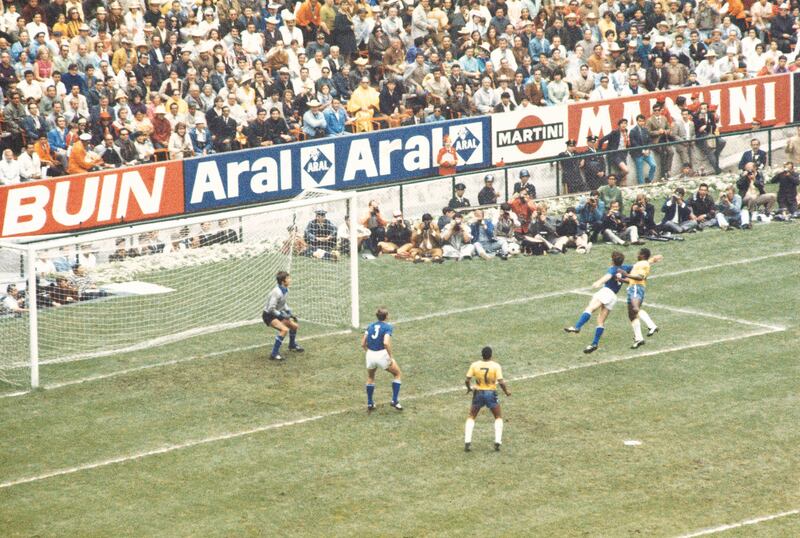In the final seconds of the 1958 World Cup final, with Brazil already 4-2 ahead, Pelé, then just 17 years old, received a long ball near the Swedish penalty area. He caught it on his chest, stunning it so smartly that the ball dropped at his feet. He stepped over the ball and effortlessly back-heeled it to a team mate. With the crowd still cheering this, the ball was lobbed back into the area and, insouciantly, Pelé flicked it with the side of his head into the goal. Within moments, Brazil had won their first World Cup, making the nation’s identity, then better known for coffee, synonymous with football. Pelé, reduced to floods of tears on the pitch, began his life as the embodiment of Brazilian football.
[ Pelé, Brazil’s World Cup winner and soccer legend, dies aged 82Opens in new window ]
[ The day Pelé and Santos didn’t live up to their billing in Dalymount ParkOpens in new window ]
[ Pelé radiated the quality of joy: an instant appeal to the eye and heartOpens in new window ]
It is worth recalling how much was riding on this moment for Brazil. The country’s scintillating Afro-Brazilian stars, such as Leônidas, first caught the world’s attention at the 1938 World Cup. Commentators at the time suggested that the country’s hybrid Afro-Indian-European demography was the greatest strength behind its football and culture. The 1950 World Cup, held in Brazil, was meant to cement this notion, but the shock defeat to Uruguay in the final game – the Maracanazo – was read as a failure of the country’s modernisation and its pathological miscegenation; the black players were made scapegoats for the defeat and racist stereotypes were reactivated. In 1958 the curse was lifted. Brazil’s super-diverse squad had become champions playing in their own unique style; Pelé was the star, and the world took notice.
He was, of course, a supremely talented athlete who would have shone in any age, but his career coincided with a golden age of Brazilian football – when the game really was the very centre of cultural life – and the explosive spread of television, which massively amplified his presence everywhere. Consequently, Pelé was the first Brazilian footballer whose cultural impact exceeded the game, and football’s first global celebrity. Two moments illustrate this.
First, was Pelé's 1,000th goal, a marker concocted by the Brazilian media that in late 1969 turned into a gigantic circus, a made-for-TV spectacle that saw journalists and cameras track his every move as the milestone came into view. When he finally scored it, live on TV, it was deemed so important that the next day, in Brazil, it was considered just as important as the Apollo 12 moon landings.
Second, the 1970 World Cup final, in which Pelé's Brazil beat Italy 4-1 is often thought to have been the finest performance of any team, ever. The gold standard – what Pelé himself termed o jogo bonito, the beautiful game. Good as the game was, what fixed the moment in the global imagination was that it was the first World Cup final to be broadcast live across the world by satellite, and the first to be available in colour – Brazil’s canary-yellow shirts, for the first time, were shown in all their chromatic glory, shimmering in the Mexican sun.

TV aside, Pelé was the first truly multimedia football star. He was celebrated in song by many of Brazil’s leading popular musicians, from Jackson do Pandeiro to Chico Buarque. Brazil’s most august poets, such as João Cabral Melo Neto, did likewise. For a time, he had his own radio show, released a number of hit records, starred in telenovelas, and has been the subject of no less than five film biographies. His own acting career, essentially playing Pele, included the cult Escape to Victory and a turn as a private-eye-cum-social-worker, in Os Trombadhinas.
Before retiring from the game, Pelé relaunched football in the United States during his five years at the New York Cosmos. In retirement he served briefly as President Fernando Henrique Cardoso’s minister of sport, before settling into his metier – being Pelé. He was the first footballer to trademark his nickname and was the face of global brands, from Pepsi to Viagra, long before anyone else.
[ Pelé and the Cosmos: How the Brazilian conquered AmericaOpens in new window ]
There will, no doubt, be much discussion as to whether he was the greatest and most celebrated football player of all time, or whether that crown, having already been lost to Argentina and Maradona in the 1980s, has now passed to Lionel Messi. Perhaps this is true. A player can only be as good as their historical moment allows. Compared to Pelé's era, players’ levels of training, fitness and medical support are immeasurably higher. Equipment is lighter and better, boots are more like ballet shoes, nutrition is much improved. Either way, for all of Maradona’s bombastic presence and Messi’s brilliance in an era of unprecedented media globalisation, both followed paths that were first forged by Pelé.
David Goldblatt is the author of The Ball is Round: A Global History of Football and The Game of Our Lives















